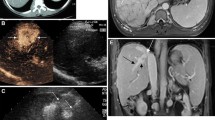Abstract
Radiofrequency capacitive hyperthermia combined with intra-arterial chemotherapy or chemoembolization was performed in 45 patients with unresectable hepatic cancer. Intratumor temperature was measured in 26 (57.8%) of the 45 patients. The overall mean maximum core temperature (Tmax) was 41.3±0.3°C (mean±SE), and the Tmax was≥42°C in nine tumors (34.6%). The tumor temperature rise was related to the power applied, embolization with degradable starch microspheres, and obstruction of the portal vein. The overall response rate was 31.1% (14/45). The response rate was 55.6% when Tmax was ≥42°C; although this was higher than the response rate of 11.8% achieved with Tmax<42°C, the difference was not significant. There were no serious adverse effects of hyperthermia.
Similar content being viewed by others
References
Erichsen C, Bolmsjo M, Hugander A, et al. Blockage of the hepatic-artery blood flow by biodegradable microspheres (Spherex) combined with local hyperthermia in treatment of experimental liver tumors in rats. J Cancer Res Clin Oncol 1985;109:38–41.
Akuta K, Hiraoka M, Jo S, et al. Regional hyperthermia combined with blockade of the hepatic arterial blood flow by degradable starch microspheres in pigs. Int J Radiat Oncol Biol Phys 1987;13:239–242.
Nagata Y, Hiraoka M, Akuta K, et al. Radiofrequency thermotherapy for malignant liver tumors. Cancer 1990;651:1730–1736.
Tada I, Suzuki K, Okada K, et al. Multidisciplinary treatment for inoperable liver cell carcinoma. Clinical study of the therapy of the arterial infusion of MFA—Lipiodol—emulsion with hyperthermia (in Japanese with English abstract). Jpn J Hyperthermic Oncol 1989;3:369–374.
Yoshikawa T, Oyamada H, Ichikawa H, et al. Antitumor effect and indication of chemoembolization using degradable starch microspheres and regional hyperthermia in patients with hepatocellular carcinoma (in Japanese with English abstract). J Jpn Soc Cancer Ther, 1989;24:786–792.
Kikuchi M, Amemiya Y, Egawa S, et al. Guide to the use of hyperthermic equipment. 1. Capacitively-coupled heating. Int J Hyperth 1993;9:187–203.
Yanagawa S, Sone Y, Doi H, et al. A new procedure for the prevention of surface overheating in deep hyperthermia using RF capacitive heating equipment (in Japanese with English abstract). Jpn J Hyperthermic Oncol 1985;1:187–191.
Moffat FL, Falk RE, Calhoun K, et al. Effect of radiofrequency hyperthermia and chemotherapy on primary and secondary hepatic malignancies when used with metronidazole. Surgery 1983;94:536–542.
Yonemura Y, Fujita T, Takegawa S, et al. Clinical experience with RF thermotherapy for nonresectable primary and secondary liver tumors (in Japanese with English abstract). Jpn J Hyperthermic Oncol, 1987;3:41–47.
Lindll B, Aronsen KF, Rothman U. Reperated arterial embolization of rat livers by degradable microspheres. Eur Surg Res 1977;9:347–356.
Lindverg B, Lote K, Teder H. Biodegradable starch microspheres—a new medical tool. In: Davis SS, Illum L, McVie JG, Tomlinson E (eds) Microspheres and drug therapy. Amsterdam: Elsevier 1984;153–188.
Oleson JM, Dalice AS, Manning MR. Analysis of prognostic variables in hyperthermia treatment of 161 patients. Int J Radiat Oncol Biol Phys, 1984;10:2231–2239.
Arcangeli G, Benassi M, Cividalli A, et al. Radiotherapy and hyperthermia. Analysis of clinical results and identification of prognostic variables. Cancer 1987;60:950–956.
Zee J, Putten WLJ, Berg AP, et al. Retrospective analysis of the response of tumors in patients treated with combination of radiotherapy and hyperthermia. Int J Hyperth 1986;2:337–349.
Leopold KA, Dewhirst M, Samulski T, et al. Relationships among tumor temperature, treatment time, and histopathological outcome using preoperative hyperthermia with radiation in soft tissue sarcoma. Int J Radiat Oncol Biol Phys 1992;22:989–998.
Akuta K, Jo S, Hiraoka M, et al. Histological changes of the normal liver by local hyperthermia (in Japanese with English abstract). Jpn J Hyperthermic Oncol 1988;4:1–8.
Miyazaki M, Makowka L, Falk RE, et al. Hyperthermoche-motherapeutic in vivo isolated perfusion of the rat liver. Cancer 1983;51:1254–1260.
Reed WA, Manning RT, Hopkins LT. Effect of hypoxia and hyperthermia on hepatic tissue of the dog. Am J Physiol 1964;206:1304–1308.
Skibba JL, Condon RE. Hyperthermic isolation-perfusion in vivo of the canine liver. Cancer 1983;51:1303–1309.
Prionas SD, Jayler MA, Fajardo LF, et al. Thermal sensitivity to single and double heat treatment in normal canine liver. Cancer Res 1985;45:4791–4797.
Author information
Authors and Affiliations
Rights and permissions
About this article
Cite this article
Yamamoto, K., Tanaka, Y. Radiofrequency capacitive hyperthermia for unresectable hepatic cancers. J Gastroenterol 32, 361–366 (1997). https://doi.org/10.1007/BF02934494
Received:
Accepted:
Issue Date:
DOI: https://doi.org/10.1007/BF02934494




